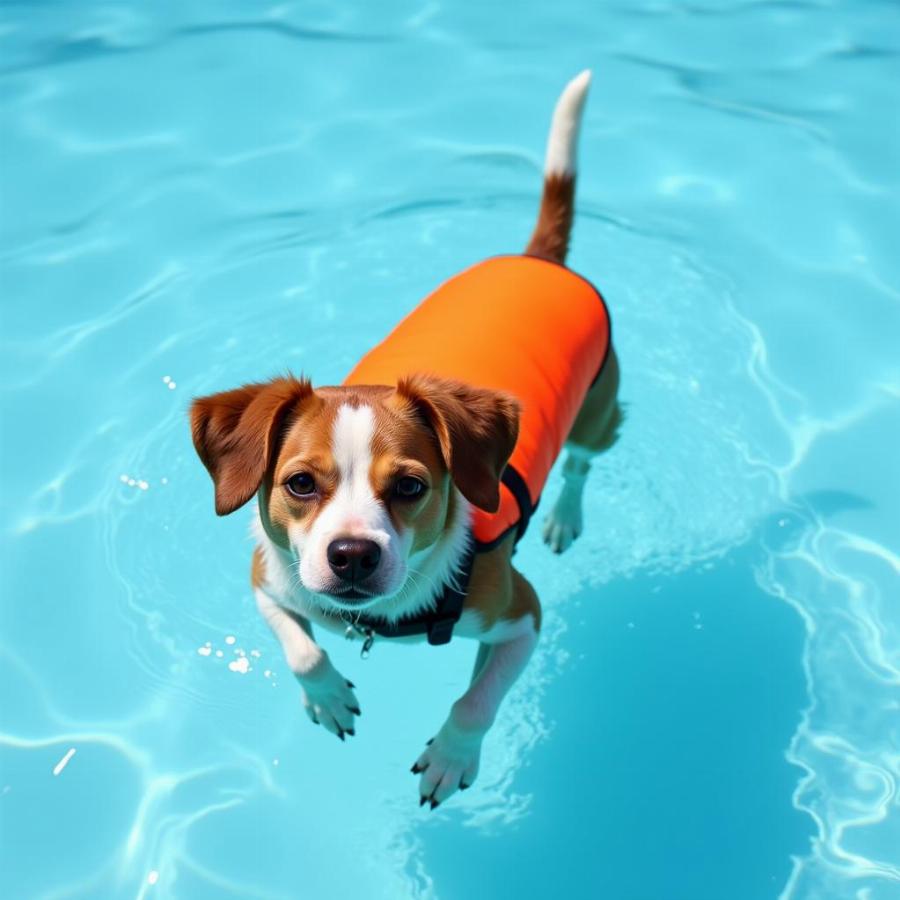Have you ever watched your furry friend gleefully paddling around in the water, a big grin plastered on their face and their tail whipping back and forth like a metronome on high speed? It’s a common sight, but have you ever stopped to think, “Why do dogs wag their tails when they swim?” While the sight of a dog swim tail might seem self-explanatory—pure, unadulterated joy—the truth is a little more nuanced.
Dogs primarily communicate through body language, and their tails are a major signaling device. While tail wags are often associated with happiness, a wagging tail doesn’t always equal a happy pup. The speed, direction, and even the tension in the wag can convey a range of emotions, from excitement to anxiety, and even potential aggression.
Decoding the Dog Swim Tail: More Than Just Happiness
So, what’s the story with the dog swim tail? While a happily wagging tail in the water can certainly indicate your dog is having a blast, it’s essential to consider the context. Here are a few possible interpretations:
1. Propulsion and Balance:
Dogs, unlike fish, don’t have fins. They rely on their four legs and, you guessed it, their tails for propulsion and balance in the water. The tail acts like a rudder, helping them steer and maintain stability. A wagging tail in this instance is simply a by-product of their swimming motion.
2. Excitement and Playfulness:
For many dogs, swimming is pure joy. It’s a chance to cool off, exercise, and engage in some instinctual water-based fun. A fast, broad wag, often accompanied by a happy, open-mouthed grin, is a clear indicator that your dog is having a whale of a time.
“Swimming is a fantastic outlet for a dog’s energy,” says Dr. Emily Carter, a certified veterinary behaviorist. “A dog who’s genuinely enjoying their swim will often have a relaxed body posture and a loose, fluid tail wag.”
3. Communication with Other Dogs:
Just like on land, dogs use their tails to communicate with each other in the water. A wagging tail can signal a playful invitation or a friendly greeting to other canine swimmers.
4. Anxiety or Fear:
A tucked tail, or a tail wagging low and slowly, could indicate that your dog is feeling anxious or uncomfortable in the water. This is especially true for dogs who are new to swimming or who have had a negative experience in the past.
Recognizing the Signs of a Stressed Swimmer:
It’s crucial to be able to differentiate between a happy swimmer and a stressed one. Keep an eye out for these signs, which may indicate your dog isn’t enjoying their aquatic adventure:
- Frantic paddling: Unlike the smooth, coordinated movements of a confident swimmer, a dog who is panicking may paddle erratically and appear to be struggling to stay afloat.
- Whining or whimpering: Vocalizations like whining or whimpering are clear signs of distress.
- Wide, panicked eyes: A dog who is scared will often have dilated pupils and a tense facial expression.
- Trying to climb onto people or objects: A dog who is desperate to get out of the water may try to climb onto their owner or any nearby objects.
If you notice any of these signs, it’s crucial to remove your dog from the water immediately and provide reassurance.
 Small dog wearing a life jacket swimming in a pool
Small dog wearing a life jacket swimming in a pool
Making Swimming Enjoyable for Your Dog:
Swimming should be a fun and enriching experience for your dog. Here are a few tips to ensure your furry friend stays safe and happy in the water:
- Start slowly: Introduce your dog to the water gradually, allowing them to acclimate at their own pace.
- Use positive reinforcement: Offer praise, treats, and encouragement to create positive associations with swimming.
- Consider a life jacket: A properly fitted life jacket can provide an extra layer of safety, especially for dogs who are new to swimming or who are not strong swimmers.
- Never force your dog to swim: Some dogs simply don’t enjoy swimming, and that’s okay. Respect their boundaries and never force them into the water.
Conclusion:
The next time you see that dog swim tail in action, take a moment to observe your furry friend’s overall body language. With a little practice, you’ll be able to decode their signals and understand whether they’re experiencing pure joy or a touch of anxiety in the water. Remember, a safe and happy swim is all about understanding your dog’s individual needs and respecting their limits.
FAQs:
- Do all dogs instinctively know how to swim? Not all dogs are natural swimmers. Some breeds, like Bulldogs and Dachshunds, have body types that make swimming more challenging.
- Is it safe to let my dog swim in pools treated with chlorine? While chlorine isn’t ideal for dogs, small amounts are generally considered safe. Rinse your dog off with fresh water after swimming to minimize chlorine exposure.
- What should I do if my dog seems afraid of the water? Never force a fearful dog into the water. Seek guidance from a certified professional dog trainer or behaviorist for help with water acclimation.
Need more advice on keeping your furry friend happy and healthy? Contact us at [email protected] for expert tips and guidance.
Beaut Dogs is your one-stop resource for all things dog-related. From breed information to training tips, we’re here to help you navigate the wonderful world of dog ownership.